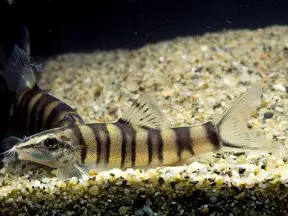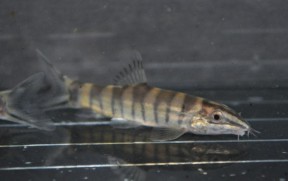Sinibotia robusta
Kansu Loach
SynonymsTop ↑
Botia robusta Wu, 1939; Botia hexafurca Mai, 1978
Classification
Order: Cypriniformes Family: Botiidae
Distribution
Described from ‘Li Kiang, southern China’, which presumably refers to the place of the same name near Nanning city, Guangxi Autonomous Region.
Nanning is located at the confluence of the You and Zuo river systems which combine to form the Yong Jiang (Yong River) as it flows through the city, after which it’s known as the Yu Jiang. The Yu later joins the Xi Jiang, a major tributary of the famous Zhu Jiang (Pearl River).
S. robusta has been recorded from several other tributary drainages of the Zhu Jiang system including the Liu Jiang and Gui Jiang. The Zhu drains most of Guangxi plus Guangdong province, with parts of its upper reaches extending into parts of Yunnan, Guizhou, Hunan and Jiangxi provinces, plus northern Vietnam.
The area is one of the most populous and industrialised in China so much of the main Zhu channel is now highly polluted, particularly in its lower reaches.
Habitat
Not much information is available but presumably inhabits moderate-to-slowly flowing stretches of streams or main river channels with clear water plus substrates of sand and rocks, as do other members of the genus.
Sympatric species often include Tor brevifilis, Onychostoma ovale, O. lini, O. gerlachi, Cirrhinus molitorella, Luciocyprinus langsoni, Saurogobio dabryi, Cobitis sinensis, Parabotia fasciata, Sinibotia reevesae, and Silurus asotus.
Maximum Standard Length
90 – 100 mm.
Aquarium SizeTop ↑
An aquarium base measuring at least 120 ∗ 30 cm or equivalent is recommended.
Maintenance
All botiid loaches need a well-structured set-up although the actual choice of décor is more-or-less down to personal taste.
A natural-style arrangement could include a substrate of sand or fine gravel with plenty of smooth, water-worn rocks and pebbles plus driftwood and branches.
Lighting can be relatively subdued and plants able to grow in such conditions like Microsorum, Taxiphyllum, or Anubias spp. can be added if you wish. These have an added benefit as they can be attached to pieces of décor in such a way as to provide useful shade.
Otherwise be sure to provide plenty of cover as botiids are inquisitive and seems to enjoy exploring their surroundings. Rocks, wood, flower pots and aquarium ornaments can be used in whichever combination to achieve the desired effect.
Bear in mind that these fish like to squeeze themselves into small gaps and crevices so items with sharp edges should be omitted, and any gaps or holes small enough for a fish to become trapped should be filled in with aquarium-grade silicone sealant. A tightly-fitting cover is also essential as they may jump at times.
Sinibotia spp. appear to prefer faster-flowing water than most botiids and can be maintained in larger hill stream-style set-ups, though provided the water is well-oxygenated with a degree of flow very turbulent conditions aren’t mandatory.
They are however intolerant to accumulation of organic wastes and requires spotless water in order to thrive. For this reason they should never be introduced to biologically immature set-ups and adapt most easily to stable, mature aquaria.
In terms of maintenance weekly water changes of 30-50% tank volume should be considered routine.
Water Conditions
Temperature: 20 – 25.5 °C
pH: 6.5 – 8.0
Hardness: 36 – 268 ppm
Diet
Likely to be a benthic predator hunting insects, crustaceans, and smaller fishes in nature.
Captive specimens aren’t fussy but should be offered a varied diet comprising live or frozen bloodworm, Tubifex, chopped shellfish, earthworms and good quality, sinking dried foods.
Once settled into the aquarium feeding behaviour can be somewhat vigorous with the fish often ascending into midwater to feed.
Behaviour and CompatibilityTop ↑
This species is typically reclusive and tends to occupy quieter areas of the tank or remain under cover when not feeding. It’s also very peaceful and safe to keep with many other fishes provided they can cope with the same environmental conditions.
Particularly suitable tankmates include pelagic cyprinids such as many Devario, Rasbora, ‘Puntius‘, Mystacoleucus, and some Danio spp., while in larger tanks members of Barilius, Luciosoma, Balantiocheilos, and Barbonymus become options.
In terms of other bottom-dwellers this species should do well alongside most Botia and Sinibotia spp. and in very large tanks, Chromobotia macracanthus.
Many balitorid, cobitid, gastromyzontid and nemacheilid loaches are also possibilities as are members of Epalzeorhynchos, Crossocheilus, and Garra plus many catfishes.
As always, thorough research prior to selecting a community of fishes is the best way to avoid problems.
Sinibotia spp. are gregarious and seemingly form complex social hierarchies, therefore 3-4 specimens should be the minimum purchase.
When kept singly they occasionally become withdrawn or aggressive towards similarly-shaped fishes, and if only a pair or trio are purchased the dominant individual may stress the other(s) to the extent that they stop feeding.
Sexual Dimorphism
Unconfirmed but females should be heavier-bodied once sexually mature.
Reproduction
Unrecorded in aquaria; presumably a seasonal, possibly migratory spawner in nature.
NotesTop ↑
This species is also sold under the vernacular names ‘golden Chinese loach’ and ’12-banded Chinese loach’. Along with S. pulchra it’s the most commonly-traded member of the genus, and the two are often imported in mixed batches, presumably because they occur and are thus collected together in nature.
Congeners possess flexible, sinuous bodies but this character is less pronounced in S. robusta with it possessing an overall deeper, stockier body shape.
It was previously considered to belong to the genus Botia with the earliest reference regarding its inclusion in Sinibotia we’ve been able to find being Nalbant (2002). However, no reasoning is given in that study so the move may have been proposed earlier.
Neither have we been able to obtain any solid diagnostic information but at any rate it’s easy to tell apart from other Sinibotia spp. since it has a relatively deeper, more compact body shape. Young specimens tend to have around 6 dark, vertical body bars but these usually bifurcate as the fish mature.
The genus Sinibotia currently contains six species, all of which are native to China plus in at least one case, Laos. All were also previously considered to belong to Botia.
Not a great deal of information has been published since the turn of the century but Yang and Chen (1992) stated that it can be separated from related genera by the following combination of characters: suborbital spine strong and bifurcate; top of cranium without fontanelle; possession of three pairs of barbels and one pair of mental ‘buttons’ (rounded mental lobes in lower lip); minute scales; cheeks scaleless; dorsal-fin located closer to caudal-fin base then snout; caudal-fin forked; anterior portion of swim bladder usually enclosed in a partial-to-completely ossified capsule, posterior portion of swim bladder not enclosed.
The family Botiidae has been widely considered a genetically distinct grouping since Nalbant (2002), having previously been considered a subfamily (Botiinae) of the family Cobitidae. Nalbant also moved some previous members of Botia into the new genus Yasuhikotakia based on a number of morphological characters.
Later Kottelat (2004) made further modifications to the taxonomy, raising Chromobotia for B. macracanthus and confirming that species previously included in the genus Hymenophysa should instead be referred to Syncrossus.
The former alteration was based on colour pattern plus some morphological characters and the latter because Hymenophysa not only represents a spelling mistake (McClelland’s original spelling was Hymenphysa) but is a junior synonym of Botia.
More recently Kottelat (2012) erected the genus Ambastaia to accommodate A.nigrolineata and A. sidthimunki, two former members of both Botia and Yasuhikotakia.
As a result of these works the family Botiidae is thus divided into two tribes within which Botia appears to be the most basal lineage:
Tribe Leptobotiini – Leptobotia, Parabotia, Sinibotia.
Tribe Botiini – Ambastaia, Botia, Chromobotia, Syncrossus, Yasuhikotakia.
Phylogenetic studies by Tang et al. (2005) and Šlechtová et al. (2006) have largely confirmed this system to be correct although the latter disagreed with the placement of Sinibotia, finding it to be more closely related to the tribe Botiini.
Ambastaia nigrolineata and A. sidthimunki were found to be more closely-related to both Sinibotia and Syncrossus than Yasuhikotakia, despite being considered members of the latter at the time. Šlechtová et al. also proposed the use of subfamily names under the following system:
Subfamily Leptobotiinae – Leptobotia, Parabotia.
Subfamily Botiinae – Botia, Chromobotia, Sinibotia, Syncrossus, Yasuhikotakia.
Within these Botia appears to be the basal, i.e., most ancient, lineage and in a more-detailed phylogenetic analysis Šlechtová et al. (2007) confirmed the validity of the family Botiidae with the genera listed above as members rather then being grouped into subfamilies. This more recent, simpler system is the one we currently follow here on SF.
Sinibotia spp. also possess sharp, motile, sub-ocular spines which are normally concealed within a pouch of skin but erected when an individual is stressed, e.g., if removed from the water. Care is therefore necessary as these can become entangled in aquarium nets and those of larger specimens can break human skin.
Botiids are also susceptible to a condition commonly referred to as ‘skinny disease’ and characterised by a loss of weight. This is especially common in newly-imported specimens and is thought to be caused by a species of the flagellate genus Spironucleus.
It’s treatable although the recommended medication varies depending on country. Hobbyists in the UK tend to use the antibiotic Levamisole and those in the United States Fenbendazole (aka Panacur).
References
- Kottelat, M., 2001 - Environment and Social Development Unit, East Asia and Pacific Region. The World Bank: i-iii + 1-123 + 1-18
Freshwater fishes of northern Vietnam. A preliminary check-list of the fishes known or expected to occur in northern Vietnam with comments on systematics and nomenclature. - Kottelat, M., 2004 - Zootaxa 401: 1-18
Botia kubotai, a new species of loach (Teleostei: Cobitidae) from the Ataran River basin (Myanmar), with comments on botiine nomenclature and diagnosis of a new genus. - Kottelat, M., 2012 - Raffles Bulletin of Zoology Supplement 26: 1-199
Conspectus cobitidum: an inventory of the loaches of the world (Teleostei: Cypriniformes: Cobitoidei). - Nalbant, T. T., 2002 - Travaux du Museum d'Histoire Naturelle 'Grigore Antipa' 44: 309-333
Sixty million years of evolution. Part one: family Botiidae (Pisces: Ostariophysi: Cobitoidea). - Nalbant, T. T., 2004 - Travaux du Museum d'Histoire Naturelle 'Grigore Antipa' 47: 269-277
Hymenphysa, Hymenophysa, Syncrossus, Chromobotia and other problems in the systematics of Botiidae. A reply to Maurice Kottelat. - Tang, Q., B. Xiong, X. Yang, and H. Liu, 2005 - Hydrobiologia 544(1): 249-258
Phylogeny of the East Asian botiine loaches (Cypriniformes, Botiidae) inferred from mitochondrial cytochrome b gene sequences. - Tang, Q., H. Liu, R. Mayden and B. Xiong, 2006 - Molecular Phylogenetics and Evolution 39(2): 347-357
Comparison of evolutionary rates in the mitochondrial DNA cytochrome b gene and control region and their implications for phylogeny of the Cobitoidea (Teleostei: Cypriniformes). - Yang, J.-X. and Y.-R. Chen, 1992 - Ichthyological Exploration of Freshwaters 2(4): 341-349
Revision of the subgenus Botia (Sinibotia) with description of a new species (Cypriniformes: Cobitidae). - Šlechtová, V., J. Bohlen, and H. H. Tan, 2007 - Molecular Phylogenetics and Evolution 44(3): 1358-1365
Families of Cobitoidea (Teleostei; Cypriniformes) as revealed from nuclear genetic data and the position of the mysterious genera Barbucca, Psilorhynchus, Serpenticobitis and Vaillantella. - Šlechtová, V., J. Bohlen, J. Freyhof, and P. Ráb, 2006 - Molecular Phylogenetics and Evolution 39(2): 529-541
Molecular phylogeny of the Southeast Asian freshwater fish family Botiidae (Teleostei: Cobitoidea) and the origin of polyploidy in their evolution.







